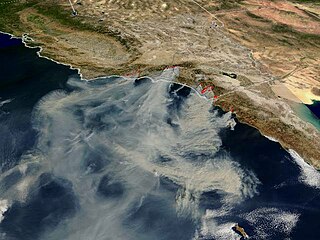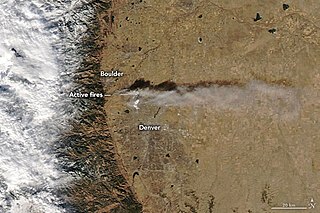Related Research Articles

The City of Louisville is a home rule municipality located in southeastern Boulder County, Colorado, United States. The city population was 21,226 at the 2020 United States Census. Louisville began as a mining community in 1877, experienced a period of labor violence early in the 20th century, and transitioned to a suburban residential community when the mines closed in the 1950s.

Superior is a statutory town in Boulder County, Colorado, United States, with a small, uninhabited segment of land area extending into Jefferson County. According to the 2020 census, the population of the city was 13,094.

The Cedar Fire was a massive, highly-destructive wildfire, which burned 273,246 acres (1,106 km2) of land in San Diego County, California, during October and November 2003. The fire's rapid growth was driven by the Santa Ana wind, causing the fire to spread at a rate of 3,600 acres (15 km2) per hour. By the time the fire was fully contained on November 4, it had destroyed 2,820 buildings and killed 15 people, including one firefighter. Hotspots continued to burn within the Cedar Fire's perimeter until December 5, 2003, when the fire was fully brought under control.

The Biscuit Fire was a massive wildfire in 2002 that burned nearly 500,000 acres in the Rogue River–Siskiyou National Forest, in southern Oregon and northern California, in the Western United States. The fire was named after Biscuit Creek in southern Oregon. The Biscuit Fire was the second-largest wildfire in the modern post-1900 history of Oregon. Oregon's largest fires are actually believed to have taken place in the 1800s. The Silverton Fire of 1865 is listed as Oregon's largest at over 900,000 acres. The Biscuit Fire area is subject to warm, dry winds known as the Brookings effect, driven by high pressure over the Great Basin. The fire re-burned portions of the 1987 Silver Fire, and much of its area was re-burned in the 2017 Chetco Bar Fire.

Last Chance is an unincorporated community in Washington County, Colorado, United States. Last Chance is situated at the intersection of U.S. Highway 36 and State Highway 71 in a sparsely populated area of northeastern Colorado. The town was supposedly so named because it was once the only place for travelers to secure fuel and provisions for many miles in any direction. The U.S. Post Office at Woodrow now serves Last Chance postal addresses.

The Soberanes Fire was a large wildfire that burned 57 homes and killed a bulldozer operator, and cost about $260 million to suppress, making it at the time the most expensive wildfire to fight in United States history. The Soberanes Fire was the result of an illegal campfire in Garrapata State Park. The fire burned 132,127 acres (53,470 ha) along the Big Sur coast in the Los Padres National Forest, Ventana Wilderness, and adjacent private and public land in Monterey County, California. At the fire's peak, over 5,000 personnel were assigned to the blaze. At the time that it was extinguished, the Soberanes fire ranked 18th on the list of the top 20 largest California wildfires, in terms of acreage burned.

The 2020 Colorado wildfire season was a series of significant wildfires that burned throughout the U.S. state of Colorado as part of the 2020 Western United States wildfire season. With a total of 665,454 acres (269,300 ha) burned, it is Colorado's largest wildfire season on record.

The Cameron Peak fire was a wildfire that started near Chambers Lake, Colorado, 25 miles (40 km) east of Walden and 15 miles (24 km) southwest of Red Feather Lakes near Cameron Pass on August 13, 2020, and was declared 100% contained on December 2, 2020. The fire burnt 208,663 acres through the Arapaho and Roosevelt National Forests in Larimer and Jackson Counties and Rocky Mountain National Park. At its peak, the fire forced the evacuation of over 6,000 residents in Estes Park, Chambers Lake, Rustic, Glacier View Meadows, Red Feather Lakes, Masonville, Glen Haven, Spring Canyon, various small communities along Highway 14, Stove Prairie Landing Road, as well as the Colorado State University Mountain Campus and had over 1,000 personnel fighting the fire. 469 structures were destroyed by the fire, including 220 outbuildings and 42 primary residences. The fire became the largest wildfire in Colorado history, surpassing the Pine Gulch Fire, which had set the same mark just seven weeks prior.
The 2021 New Mexico wildfire season began in February 7, 2021. As of July 7, there have been at least 363 fires across the state that have burned at least 121,277 acres (49,079 ha).

The 2021 Colorado wildfire season was a series of wildfires that burned throughout the U.S. state of Colorado. According to the National Interagency Fire Center, as of July 1, 2021, at least 32,860 acres (13,300 ha) of land have burned in at least 337 wildland fires across the state. Hundreds of homes were burned, and the cities of Louisville and Superior were evacuated, during the Boulder County fires in late December.

The Dixie Fire was an enormous wildfire in Butte, Plumas, Lassen, Shasta, and Tehama Counties, California. It was named after Dixie Road, near where the fire started in Butte County. The fire began in the Feather River Canyon near Cresta Dam on July 13, 2021, and burned 963,309 acres (389,837 ha) before being 100% contained on October 25, 2021. It was the largest single wildfire in recorded California history, and the second-largest wildfire overall. The fire damaged or destroyed several small towns or communities, including Greenville on August 4, Canyondam on August 5, and Warner Valley on August 12.

On December 15, 2021, the Midwestern U.S. state of Kansas was met with strong and damaging winds caused by the December 2021 Midwest derecho and tornado outbreak, which produced dust storms and multiple wildfires. An estimated 163,000 acres (66,000 ha) burned on the first day wildfires spawned due to dry fuel and strong wind gusts reaching up to 100 mph (160 km/h). The western and central portions of Kansas were mostly affected by the fires. Before December 15, forecasters had predicted that dry air, gusty winds, and warm temperatures could be present throughout the following days, creating conditions favorable for wildfires to spread quickly through the area. The largest wildfire, the Four County Fire, burned numerous buildings and killed hundreds of cattle along the way with a scorched area of 121,622 acres (49,219 ha).

The Marshall Fire was a destructive wildfire and urban conflagration that started on December 30, 2021, shortly after 11:00 a.m. MST, as a grass fire in Boulder County, Colorado. The fire killed two people and became the most destructive fire in Colorado history in terms of buildings destroyed.
The 2022 wildfire season involves wildfires on multiple continents.

The 2022 California wildfire season was a series of wildfires burning throughout the U.S. state of California. By the end of the year, a total of 7,667 fires had been recorded, totaling approximately 363,939 acres across the state. Wildfires killed nine people in California in 2022, destroyed 772 structures, and damaged another 104. The 2022 season followed the 2020 and 2021 California wildfire seasons, which had the highest and second-highest (respectively) numbers of acres burned in the historical record, with a sharp drop in acreage burned.
The Colorado Fire was a wildfire that burned near Big Sur, in Monterey County, California. The fire was first reported around 7:30 p.m. PST on January 21, 2022. As of February 3, 2022, the fire burned 687 acres (278 ha) and was 100% contained. The suspected cause of the fire is said to be from a formerly controlled fire escaping into wildland. It is named after the road it started near, Palo Colorado Canyon Road.
References
- ↑ Sullivan, Becky (January 1, 2022). "Snow puts out Colorado wildfires with 3 people missing and nearly 1,000 homes burned". NPR. Retrieved January 2, 2022.